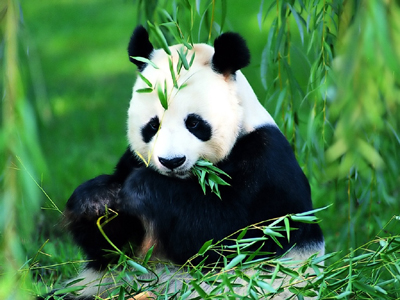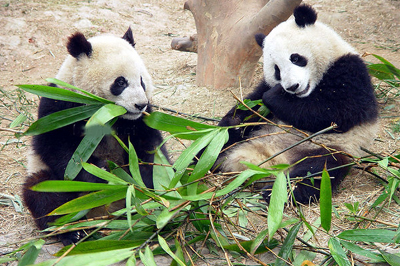Giant pandas in the wild may face food shortages as more bamboo plants, their staple food, approach the end of their lifespan, Chinese naturalists warned.
Yang Xuyu, deputy head of the Wild Animal Preservation Station of the Sichuan provincial forestry bureau in west China, issued the warning on Sunday during the annual meeting of the China Giant Panda Breeding Technical Committee. The meeting was held in Chengdu, the capital of Sichuan Province.
Yang said that the station has observed 24,000 hectares of bamboo flowering in Sichuan, where 1,206 pandas live in 40 nature reserves with a total area of 1.77 million hectares, accounting for 77 percent of the total panda habitat in China.
During the blooming process, the bamboo plant grows flowers, releases its seeds, dries out, and dies.

Bamboo blossoms have been spotted in 14 counties in Sichuan since 2005. Nine varieties of bamboo have been observed flowering, which accounts for 30 percent of bamboo eaten by the pandas, said Yang.
"No wild panda has been found dead of starvation. But as the area of bamboo flowering spreads, we should keep close watch on the severity of the pandas' food shortages," said Yang.
The mountainous region witnessed extensive blossoming of arrow bamboo, the pandas' favorite variety, in 1984 and 1987, causing hundreds of the endangered animals to die of starvation.
Yang said that in the past, pandas adapted to the natural recurrence of dead bamboo, which happens about every 60 years. However, in modern times, their migration paths among segmented bamboo forests have been blocked by human activities. Thus, the bamboo flowering has become a major threat to wild pandas.
He said the forestry bureau has carried out a panda rescue drive, which involves sending preservation staff to local panda habitats to provide guidance and supervision. The bureau has also formed a partnership with the World Wildlife Fund (WWF). The two organizations are drafting a plan to restore many of the pandas' migration paths.
Over 80 officials and panda experts from eight countries attended the meeting, which has been held annually since 1989, to share their research on ways to preserve the panda population.
In total, pandas feed on approximately 20 different species of bamboo. A research center for endangered animals in China's western Shaanxi Province carried out tests aimed at helping pandas diversify their taste in bamboo. Researchers collected 90 bamboo species that are known to be edible and fed those types to six captive pandas. The center said that the test results would be useful for aiding populations on panda reserves.

(Xinhua News Agency November 12, 2007)








